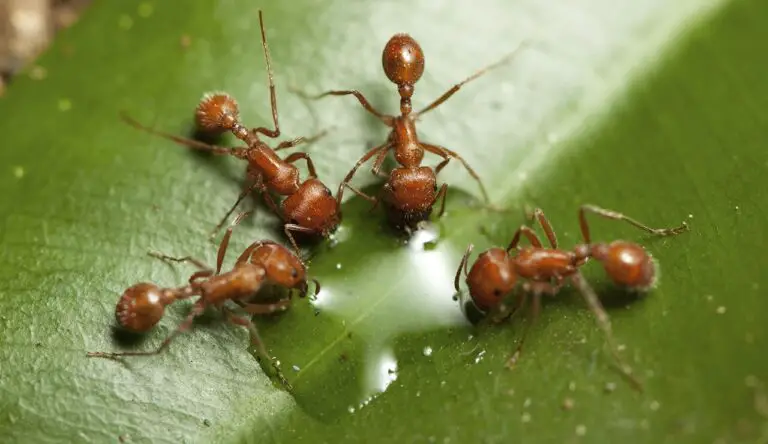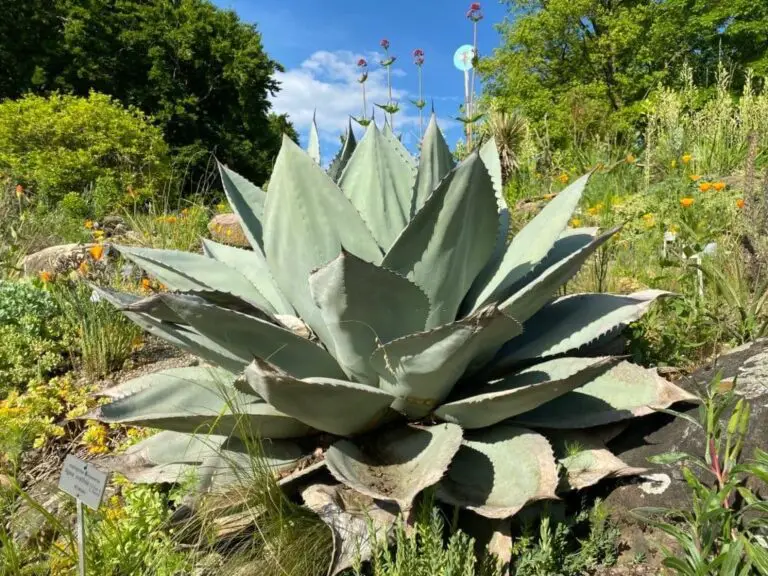26 Juniper Trees And Shrubs: Types, Identification, Leaves, And Care (Photos)
If you’re unsure about the type of juniper tree or shrub in your yard, this blog post is here to help. Junipers are popular evergreen trees that come in many shapes and sizes, making them versatile for landscaping and privacy hedges. With over 50 species, identification can be a challenge. We’ll provide tips on how to identify different types of juniper trees, as well as offer guidance on watering, fertilizing, and pruning.
In addition, we’ll cover the unique features of each species, including leaves, cones, berries, and bark. From the Alligator Juniper to the Western Juniper, we’ve got you covered. Whether you’re a seasoned gardener or just starting out, this post aims to be a comprehensive resource for juniper enthusiasts. We’ll also address common questions about junipers, such as whether they are low maintenance, poisonous to dogs, and what their benefits are.
Juniper tree facts
Junipers, belonging to the Cupressaceae family, boast distinctive evergreen needles and a robust, woody aroma. With approximately 60 species scattered across diverse habitats worldwide, from frigid mountainous regions to arid deserts, these coniferous plants have adapted to thrive in various environments. Juniper trees possess an impressive array of applications, including the use of their wood for construction purposes due to its exceptional strength and durability.
Additionally, juniper oil is used in a range of products, such as perfumes, soaps, and cosmetics.
Juniper Trees vs Juniper Shrubs
When it comes to juniper plants, you’ll encounter two main types: trees and shrubs. While both boast unique charm, they exhibit distinct growing habits. To guide your decision-making process, let’s delve into the characteristics of each type. Juniper trees can reach impressive heights of up to 30 feet, displaying a conical or pyramidal shape that makes them an attractive focal point in any landscape. They’re versatile, too, serving as effective windbreaks or privacy screens.
In contrast, juniper shrubs tend to remain closer to the ground, typically ranging from three to six feet tall. Their compact growth habit makes them ideal for foundation plantings or hedges.
How to Identify Juniper Trees
To pinpoint juniper trees, several characteristics can be examined. One distinct feature is the arrangement of their needles, which typically come in groups of three and display a blue-green hue. Another distinguishing trait is the presence of small, dark blue-black berries, though it’s essential to note that these are poisonous to humans. For those seeking further confirmation, consulting a field guide or an expert can provide the necessary guidance.
With time and practice, one can develop the skills to confidently identify juniper trees on their own. As these trees play a vital role in ecosystems, discovering them in their natural habitats is often an exhilarating experience.
Juniper Tree Leaves
The juniper tree, a coniferous native to the northern hemisphere, boasts a distinctive appearance characterized by clusters of three sharp needles with a pungent aroma. As an evergreen, this hardy species retains its foliage throughout the year, offering a consistent display of lush greenery.
Juniper Tree Cones
While many people associate the Juniper tree with its role in gin production, few know that it has a multitude of other uses. One of the most fascinating aspects of this evergreen is its ability to produce cones, which are not only visually striking but also packed with nutrients. For centuries, humans have utilized these cones for various purposes, including as a source of sustenance and medicine.
Native to North America and Europe, the Juniper tree has been an integral part of human culture. The cones, rich in vital compounds, can be employed in a range of applications. Beyond its well-known use in gin production, the Juniper tree’s wood is prized for crafting furniture and flooring, while its berry oil finds its way into perfumes and cosmetics.
But the Juniper tree’s medicinal properties are perhaps its most valuable asset.
The berries have been traditionally used to alleviate digestive issues, making them a natural remedy for many ailments.
Juniper Berries
Juniper berries are the fruiting result of juniper trees, which are native to the northern hemisphere and can be found in North America, Europe, Asia, and North Africa. With a rich history of use in folk medicine, juniper berries have been a staple in many cultures for centuries. Today, they’re still prized for their unique flavor and aroma, which makes them a popular ingredient in various products like gin.
When consumed fresh or dried, juniper berries can add a burst of flavor to meats, sauces, and drinks. Their health benefits are also being studied, with early research suggesting they’re rich in antioxidants and vitamins A and C. Some proponents claim that the berries may offer benefits for digestion, inflammation, and even weight loss. For those interested in trying juniper berries, they can typically be found at health food stores.
As with any new addition to your diet, start with a small amount and gradually increase as needed, taking care not to overdo it – excessive consumption can have a laxative effect. Always consult with your doctor before introducing new foods or supplements into your regimen.
Juniper Tree Bark.
The Juniper tree is characterized by its distinctive bark, which has a thin, scaly texture and a reddish-brown color. In contrast, the wood of the Juniper tree is surprisingly soft and light, making it an ideal material for crafting and woodworking. Beyond its practical uses, Juniper tree bark holds significant value in traditional medicine, boasting astringent, diuretic, and stimulant properties.
Additionally, the bark can be used to create natural dyes and incense, further solidifying its importance in various cultural practices.
Types of juniper trees
A member of the cypress family, the juniper tree is a coniferous plant that boasts an impressive array of 50-60 distinct species. This remarkable diversity is reflected in its widespread distribution across North America, Europe, Asia, and Africa. Among these varieties, the Eastern red cedar stands out as one of the most prevalent types.
Alligator Juniper (Juniperus deppeana)
In the heart of Amazon, you can now shop for the unique Alligator Juniper, a species of juniper native to the southwestern United States and northern Mexico. This tree thrives in elevations ranging from 1200 to 2100 meters above sea level, where its scaly-looking bark, reminiscent of an alligator’s skin, takes center stage. The Alligator Juniper is a sturdy shrub or small tree that can grow up to 15 meters tall.
Its evergreen leaves are shaped like scales and arranged in opposite pairs or whorls of three. The cones are berry-like and a deep blue-black or purple-black color, measuring between 12-20 millimeters in diameter. This versatile species can be found growing in a wide range of habitats, including deserts, semi-deserts, foothills, and mountains. In the United States, it’s native to Arizona, New Mexico, western Texas, and southwestern Colorado.
Across the border in Mexico, you’ll find it in Sonora and Chihuahua. The Alligator Juniper plays a vital role as a food source for many animals, including deer, elk, bears, and birds. The berries are a favorite snack among over 100 species of birds, such as quail, bluebirds, robins, cedar waxwings, and juncos. Mammals like squirrels, chipmunks, raccoons, skunks, and deer also feed on the berries.
Blue Pacific Juniper (Juniperus conferta ‘Blue Pacific’)
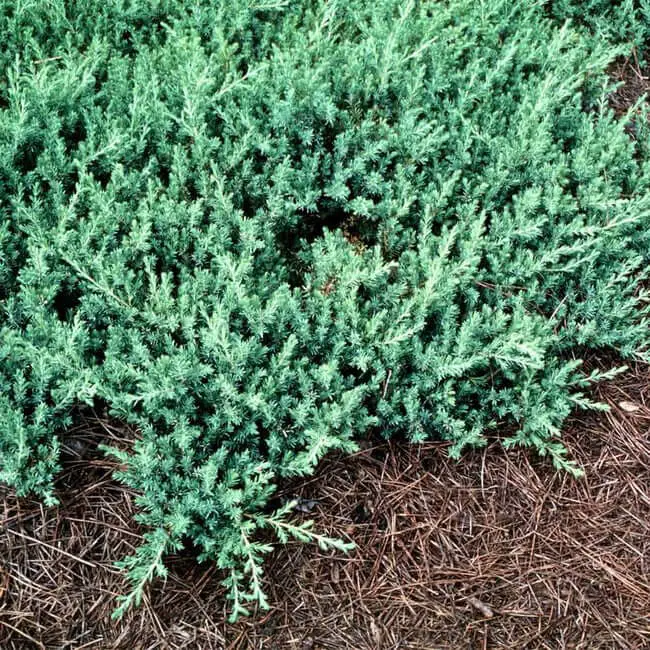
Incorporating the beauty of nature into your outdoor space has never been easier than with Blue Pacific Juniper. This stunning evergreen shrub, native to Hokkaido, Japan, thrives in growing zones 5-9 and can grow up to two meters tall with a spread of four meters wide. Its needle-like leaves, arranged in opposite pairs, display a mesmerizing blue-green hue that’s sure to catch the eye.
Beyond its visual appeal, Blue Pacific Juniper also boasts impressive cones that are spherical in shape, bearing a deep blue-black color and containing three to five seeds. This versatile juniper is not only cultivated as an ornamental plant in gardens and parks but also makes for a fantastic bonsai subject. Its preference for full sun to partial shade and well-drained soil make it adaptable to various environments.
One of the standout features of Blue Pacific Juniper is its remarkable tolerance. It can withstand salt spray, making it an excellent choice for planting near the coast. Additionally, it’s resilient against drought and windy conditions. Once established, this juniper requires minimal maintenance, making it a low-fuss addition to any outdoor space.
Blue Point Juniper (Juniperus chinensis ‘Blue Point’)

The Blue Point Juniper is a versatile evergreen shrub that thrives in growing zones four to nine, reaching heights of one to three meters. Its dense, pyramidal shape is characterized by ascending branches, with scale-like leaves on the shoots and needle-like leaves on the twigs. The cones, which are ripe when they turn blue-black, contain two seeds and grow on short, thick stalks. Native to China and Japan, this species was introduced to Europe in 1839 and the United States in 1858.
Today, it’s widely cultivated as an ornamental plant in temperate regions worldwide, and its compact size also makes it a popular choice for bonsai enthusiasts.
Blue Rug Juniper (Juniperus horizontalis ‘Wiltonii’)
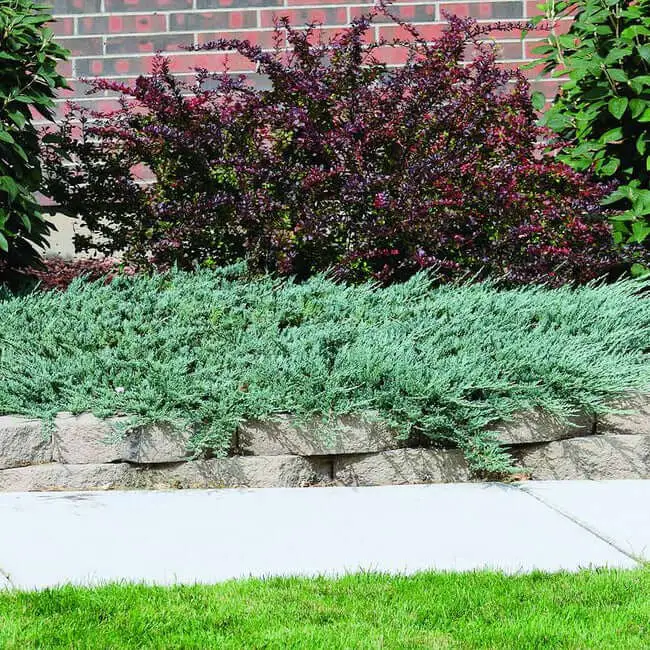
Blue Rug Juniper is a versatile and low-maintenance option for sunny areas with well-drained soils, offering a natural-looking groundcover or rock garden feature. Its dense mat of blue-green foliage forms a beautiful display year-round, withstanding full sun to partial shade. This evergreen shrub has minimal pest and disease issues, making it an ideal choice for busy gardeners.
When established, Blue Rug Juniper proves surprisingly drought-tolerant, requiring minimal care beyond occasional watering. To propagate this juniper, simply take softwood stem cuttings in late spring or early summer. With its spreading habit, be sure to provide ample space for the plant to grow and spread out over time. For a stunning display of blue-green foliage, Blue Rug Juniper is an excellent choice for sunny areas of your landscape.
Blue Star Juniper (Juniperus squamata ‘Blue Star’)

For those looking to add some texture and fragrance to their outdoor spaces, the Blue Star Juniper is an excellent choice. This stunning, slow-growing juniper thrives in zones 4-8 and can be used as a statement piece or accent plant in smaller gardens. Its soft, blue-green needles exude a pleasant aroma when touched or crushed, making it a sensory delight. Furthermore, this juniper variety is deer-resistant and can withstand drought conditions once established, reducing maintenance needs.
To get the most out of your Blue Star Juniper, be sure to plant it in full sun and well-drained soil.
Brodie Eastern Red Cedar (Juniperus virginiana ‘Brodie’)
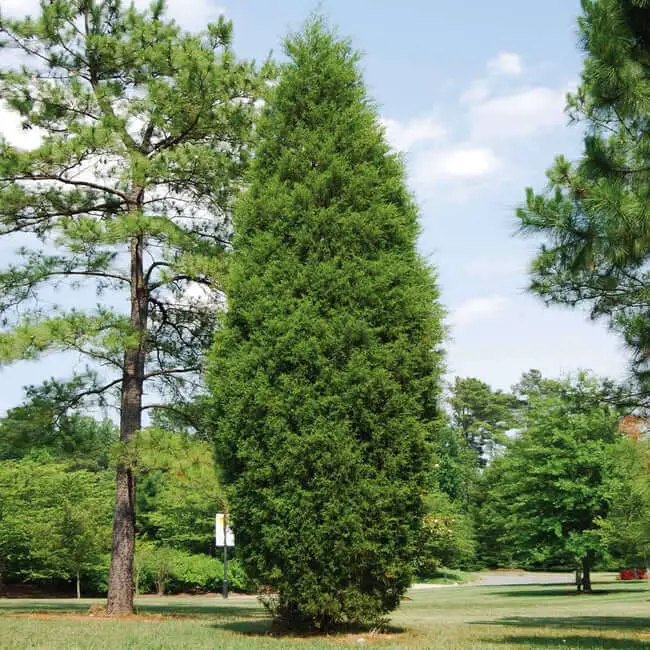
This evergreen conifer, native to North America, boasts a slow growth rate that allows it to reach impressive heights of 40 feet (12 meters) and widths of 20 feet (61 centimeters). Its unique, needle-like leaves are arranged in whorls of three, initially green before maturing into a blue-gray hue. The tree’s small, spherical cones turn brown as they ripen.
As an ornamental tree, the Brodie Eastern Red Cedar is commonly used as a Christmas tree or specimen tree, and its versatility allows it to thrive as a hedge. It thrives in conditions ranging from full sun to partial shade, with well-drained soil being essential. Notably, this tree is resilient to drought, salt, and various pests and diseases, making it an attractive addition to any landscape.
California Juniper (Juniperus californica)
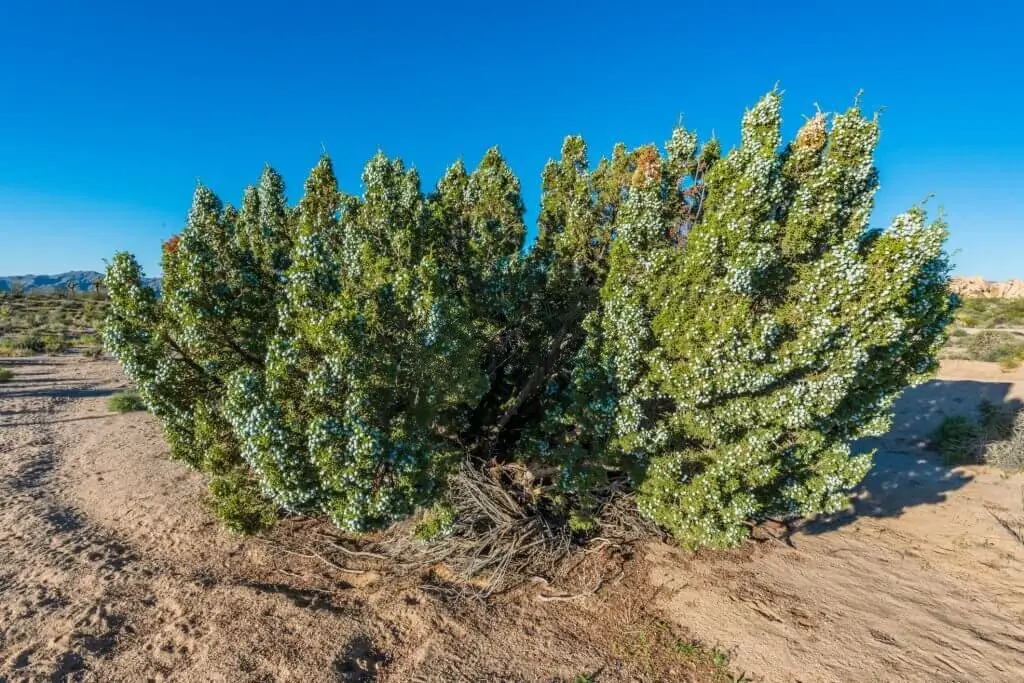
In the western United States, the California Juniper, also referred to as Southern scrub oak and Mountain mahogany, thrives in zones 8 to 10. This evergreen shrub or small tree can grow up to 15 meters (49 feet) tall, showcasing its unique characteristics.
The California Juniper’s leaves are intricately arranged in opposite decussate pairs or whorls of three, featuring a sharply pointed apex. These scale-like leaves play a crucial role in the plant’s ability to thrive.
One of the most distinctive features of the California Juniper is its berry-like cones, which are a deep blue-black color with a white waxy coating. Each cone contains three to five seeds and takes approximately 18 months to mature.
The male cones of the California Juniper are yellow in color and release their pollen in early spring, marking the beginning of the plant’s reproductive cycle.
This species is commonly found in the foothills and mountains of California, Nevada, Utah, and Arizona. In particular, it is abundant in the Sierra Nevada mountain range, where it grows at elevations ranging from 900 to 2900 meters (3000-9500 feet).
As a member of the Cupressaceae family, which includes cypresses, junipers, and redwoods, the California Juniper shares a common ancestry with these other coniferous trees.
Chinese Juniper (Juniperus chinensis)
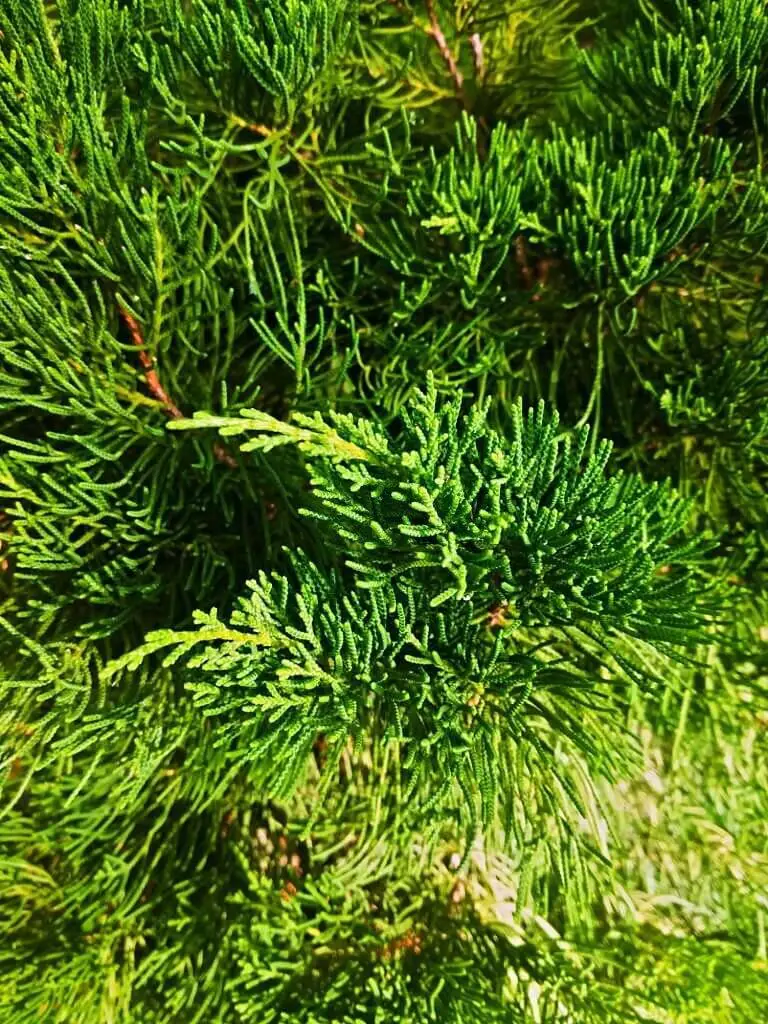
The Chinese Juniper, also known as ‘qin wen’ (), is a species of juniper native to China. This evergreen tree can grow up to 15-25 meters (49-82 feet) tall, with a trunk diameter reaching up to 60 centimeters (24 inches). Its leaves are distinctive in that they come in two forms: awl-shaped outer scales measuring 0.75-0.85 millimeters (0.030-0.033 inches) long and needle-like inner leaves approximately twice as long at around 15 millimeters (0.59 inches).
The tree’s cones, resembling berries, turn from blue-black to brown and fleshy with ripening, measuring around 12 millimeters (0.47 inches) in diameter. Each cone typically contains one to three seeds, which are dispersed through the digestive process of birds that consume the cones, depositing the seeds in their droppings elsewhere.
Common Juniper (Juniperus communis)

Common Juniper, a species of juniper native to northern Europe and northern Asia, thrives in growing zones 3 to 8. Reaching heights of 20-40 meters (66-131 feet) with trunks up to 60 centimeters (24 inches) in diameter, this evergreen tree exhibits two distinct leaf types: sharp needle-like leaves on younger plants, which gradually transform into scale-like leaves on mature specimens. Both types of leaves maintain a vibrant green hue.
The fruit of the Common Juniper takes the form of a berry, initially green and eventually ripening to a deep purple-black color. Each berry contains three seeds, serving as a vital food source for local bird populations.
Creeping Juniper (Juniperus horizontalis)

With its ability to thrive in zones 3 to 9, Creeping Juniper (Juniperus horizontalis) has become a staple in many North American landscapes. This low-growing, evergreen shrub is renowned for its ease of care and enduring visual appeal, making it an excellent choice as groundcover, in mass plantings, or as a striking accent piece.
Its remarkable hardiness allows it to flourish in a variety of conditions, including full sun and poor soils, and it boasts impressive drought tolerance once established. What’s more, Creeping Juniper requires minimal fertilization and is even deer-resistant, making it an excellent selection for those seeking low-maintenance landscaping solutions. Although pruning is rarely necessary, if required, the best time to do so is in late winter or early spring.
Additionally, this versatile plant can be easily propagated through stem cuttings. Overall, Creeping Juniper’s effortless charm and year-round interest make it a top pick for landscapers seeking reliable, low-fuss options.
Drooping Juniper (Juniperus flaccida)
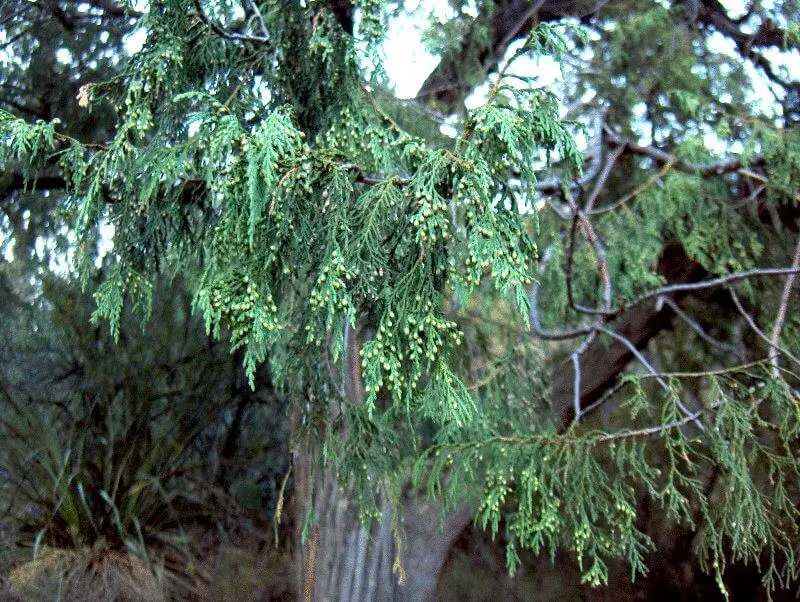
Drooping Juniper thrives in warm climates, specifically zones 8b to 11. This low-growing, spreading species typically reaches a mature height of about one foot and boasts a dense, prostrate growth habit. Its pale blue berries are a notable feature, while the soft, drooping needles add to its unique charm. As an excellent groundcover for sunny, dry areas, it can tolerate poor soils and drought once established.
Moreover, this juniper is deer resistant, making it a popular choice for gardeners seeking low-maintenance options.
Propagating Drooping Juniper is relatively straightforward, with seeds, cuttings, or layering being viable methods. For those interested in collecting seeds from the berries, late summer or fall is the ideal time to do so. The ripe berries should be slightly soft to the touch and can be released by gently rubbing them between your hands.
Store the collected seeds in a cool, dry place until you’re ready to plant them. A stratification treatment can significantly improve germination rates. Alternatively, seeds can also be sown directly into the ground during fall or spring.
Eastern Red Cedar (Juniperus Virginiana)

Eastern Red Cedar, a juniper native to eastern North America, thrives in USDA zones 2 to 9. Its natural range spans from southern Canada to northern Mexico, with introduced populations found in Europe. This evergreen tree grows up to 20-35 meters tall, with a trunk diameter of up to 60 centimeters. It often exhibits a multiple-trunked habit, forming clusters of stems that reach a maximum height of around 15 meters.
The tree’s foliage is characterized by two distinct types: juvenile needle-like leaves on younger plants and mature scale-leaves with a distinctive cedar-like appearance on older shoots. The scale leaves themselves are relatively small, measuring between 0.35-0.55 millimeters in length and 0.28-0.48 millimeters in width, with rounded apices. Floral structures take the form of monoecious cones, which appear in clusters on slightly flattened stalks. Male cones range from 0.35-0.
55 millimeters in length, while female cones are slightly larger at 0.45-0.75 millimeters.
Greek Juniper (Juniperus excelsa)
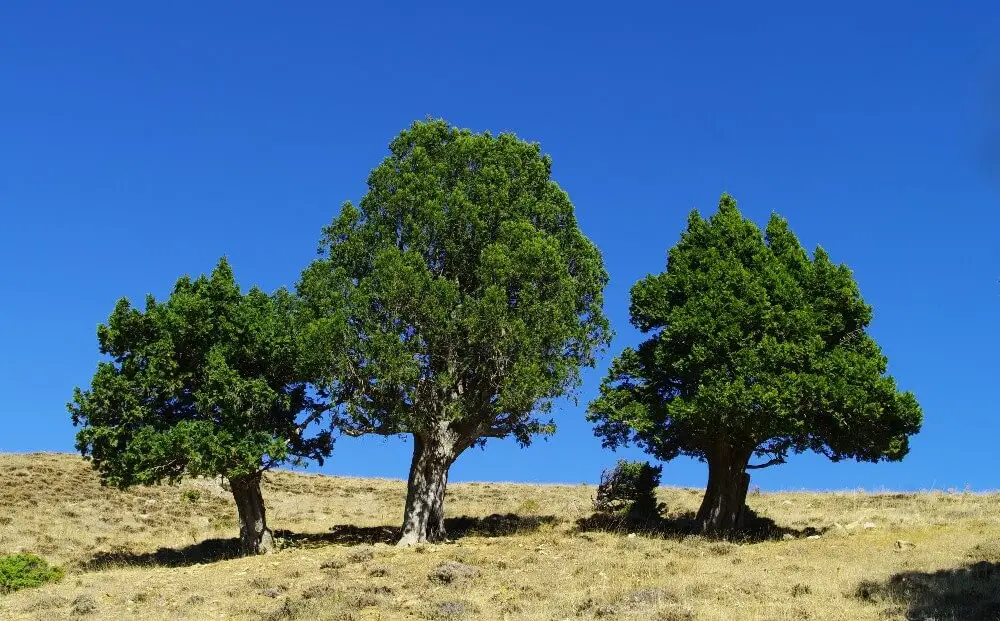
Greek Juniper (Juniperus spp.) is a resilient, evergreen shrub or small tree that thrives in zones 5 to 9. Native to Greece and Turkey, this Cupressaceae family member boasts a conical to oval-conical shape with a dense crown, characterized by two distinct leaf types: juvenile needle-like leaves transitioning to adult scale-like foliage. The cones themselves are berry-like, deep blue-black in color, containing three to five seeds.
As a dioecious species, Greek Juniper features separate male and female cones on different plants, relying on wind for pollination. This versatility has led to its use in the production of gin as well as an ornamental plant.
The wood of the Greek Juniper is particularly noteworthy, boasting exceptional hardness and durability, making it a prized material for constructing fences, buildings, and furniture.
Unfortunately, this remarkable species is classified as vulnerable on the IUCN Red List, highlighting the importance of conservation efforts to protect its continued survival.
Green Mound Juniper (Juniperus procumbens ‘Nana’)
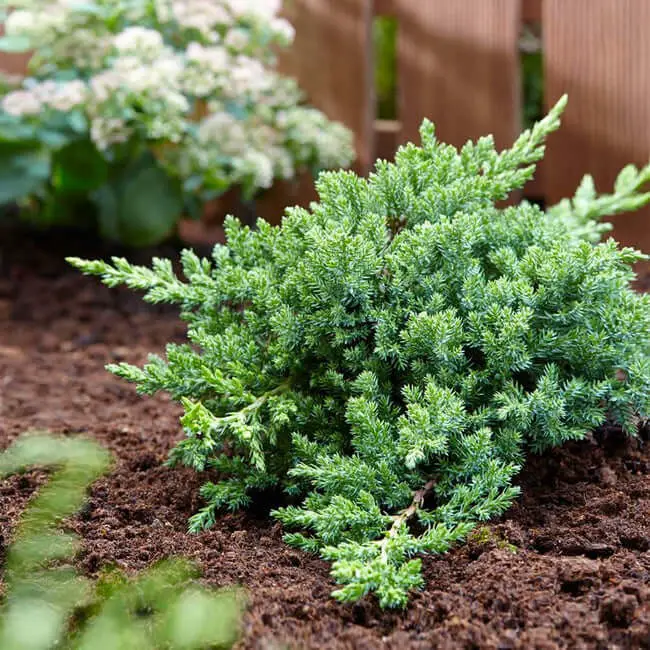
The Green Mound Juniper is an excellent option for those looking to add some low-maintenance greenery to their outdoor spaces. This spreading juniper is native to Japan, where it thrives on hillsides and mountains up to 1500 meters in elevation. Its unique scale-like leaves are arranged in opposite pairs, boasting a beautiful green to blue-green hue above and a warm yellow-green tone below.
The spherical cones that follow are a lovely shade of blue-black when ripe, containing two to three seeds within.
One of the standout features of this juniper is its adaptability. It can thrive in full sun or partial shade, making it an excellent choice for areas with varying sunlight conditions. Additionally, Green Mound Juniper is surprisingly resilient when it comes to soil type, tolerating both well-drained and moist soils with ease.
What’s more, this juniper requires minimal upkeep – no pruning necessary! While it can be pruned to maintain a desired shape if needed, the majority of care boils down to occasional watering and sunlight. Just keep in mind that Green Mound Juniper does have some susceptibility to disease and pests, such as Phomopsis tip blight, scale insects, and spider mites – but these issues are typically minor and don’t warrant control measures.
Green Mound Juniper Topiary (Juniperus procumbens ‘Green Mound’)
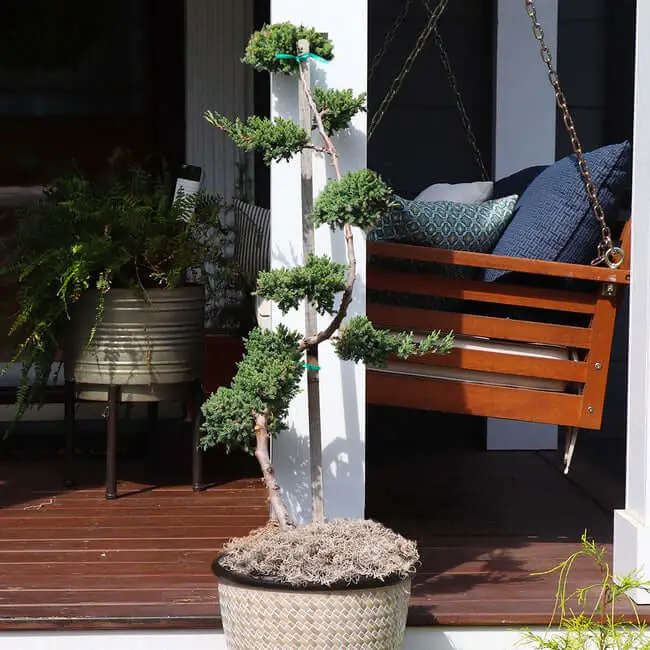
Get ready to add some evergreen charm to your space! The Green Mound Juniper Topiary is a standout choice, boasting a compact, dense shape that’s perfect for topiary. Its rich green foliage consists of neatly arranged small needles, providing year-round interest. As an added bonus, this slow-growing and low-maintenance plant is ideal for beginners. Simply prune it into the desired shape and enjoy its effortless elegance.
Hailing from Japan and Korea, this resilient juniper thrives in mountains and forests, as well as being cultivated in gardens and parks. Its popularity also extends to bonsai enthusiasts, who appreciate the Juniperus procumbens ‘Green Mound’ for its versatility and attractive appearance.
Hollywood Juniper (Juniperus chinensis ‘Kaizuka’)
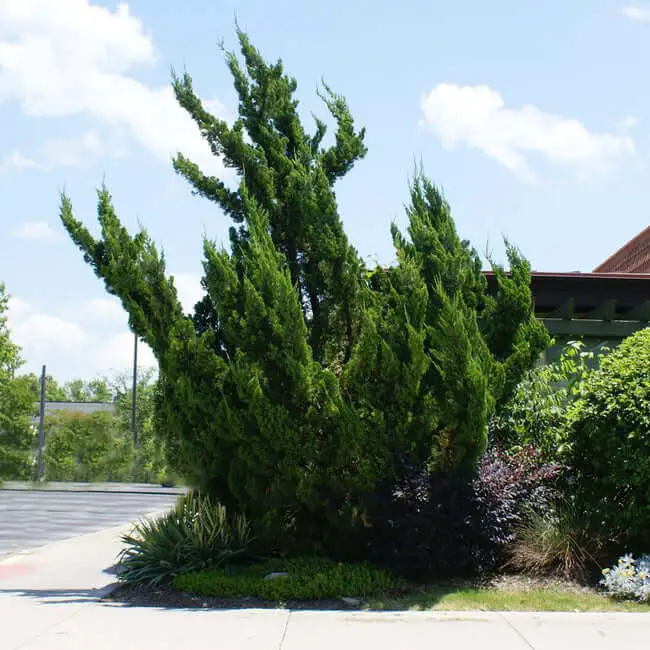
Experience the unique charm of the Hollywood Juniper by bringing one home today. This cultivar, discovered in Japan and introduced to the western world in 1901, is a slow-growing evergreen that can reach up to 20 feet tall and wide at maturity, making it an ideal choice for hedges, topiary, or accent planting. The Hollywood Juniper’s dense, dark green foliage is comprised of scale-like leaflets, which take on a striking bronze hue during the winter months.
Its adaptability to various soil types and ability to tolerate some drought once established make it a low-maintenance option. With its compact growth habit, this juniper is perfect for creating a lush and verdant landscape that can thrive in USDA Hardiness Zones 5-9.
Juniper ‘Wichita Blue’ Tree (Juniperus scopulorum ‘Wichita’)
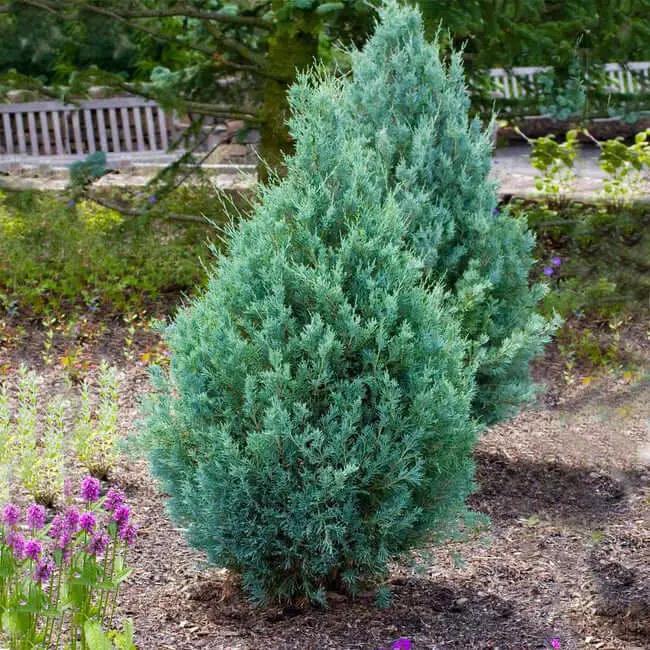
The Juniper ‘Wichita Blue’ Tree is a deciduous conifer that thrives in zones 3 to 7, boasting impressive adaptability across diverse habitats, from prairies to woodlands. This newly introduced cultivar in the early 21st century has quickly gained attention for its unique blue-green foliage, setting it apart from other color forms of the species.
Furthermore, its compact growth habit, reaching a height of only 20-30 feet at maturity, makes it an ideal choice for small yards and gardens, offering a striking yet manageable presence in even the most petite outdoor spaces.
Moonglow Juniper (Juniperus scopulorum ‘Moonglow’)
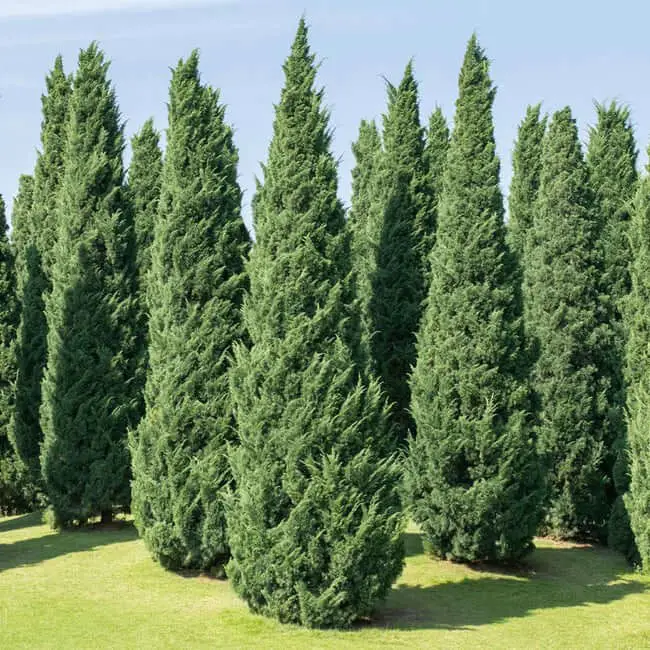
Indulge in the beauty of this stunning juniper, perfect for any landscape enthusiast! Its striking blue-green foliage makes it an ideal choice for showcasing as a specimen or grouping with other plants. With a mature height of 15 feet and width of 20 feet, be sure to provide ample space for its growth.
This juniper is impressively drought-tolerant once established, making it an excellent option for those seeking low-maintenance landscaping.
Its deer-resistant nature also ensures your landscape will remain intact, free from unwanted grazing.
For optimal results, place this shrub in full sun to partial shade. While it thrives in well-drained soil, its adaptability allows it to tolerate a broad range of soil conditions. And with its hardiness spanning zones three through eight, you can confidently plant it in your desired growing zone.
One-Seed Juniper (Juniperus monosperma)
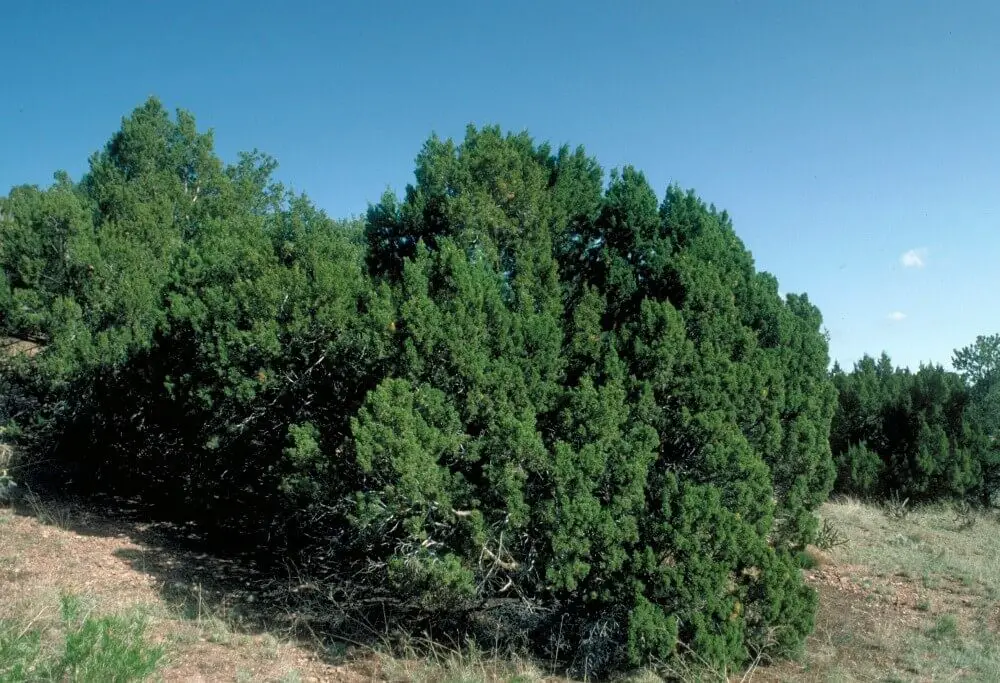
In regions with USDA Hardiness Zones 4-8, the One-Seed Juniper thrives in its natural habitat across southwestern United States and northern Mexico. This juniper species can be found at elevations of 900-2500 meters, where it grows up to 15 meters tall, though it may reach heights of 20 meters in ideal conditions.
The tree’s foliage is characterized by scale-like leaves arranged in opposite pairs or whorls of three, measuring between 0.75 and 1.5 millimeters long.
The cones are remarkable for their berry-like appearance, housing a single seed within a fleshy, scale-like structure. As the cones mature, they transition from green to purple, ultimately reaching diameters of 15-25 millimeters.
As an essential component of southwestern ecosystems, One-Seed Juniper plays a vital role in supporting local wildlife. The berries serve as a crucial food source for birds and small mammals, while the trees provide shelter and nesting sites.
Moreover, the wood is renowned for its hardness and durability, making it valuable for various applications.
This species can be found inhabiting a diverse range of environments, from arid rocky slopes to mesas and canyon bottoms. Notably, One-Seed Juniper exhibits remarkable adaptability, thriving in a broad spectrum of soils and climates. Its resilience makes it an invaluable asset for reclamation and revegetation initiatives.
Parson’s Juniper (Juniperus squamata expansa ‘Parsonii’)
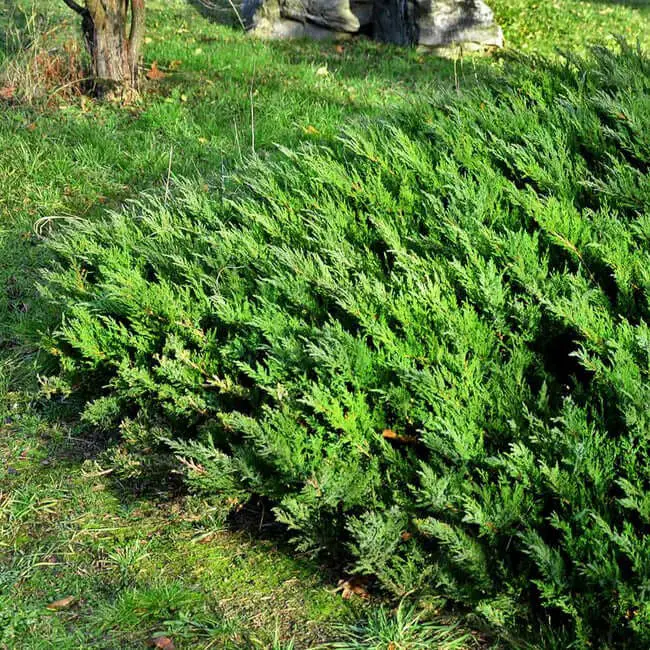
For those seeking a low-fuss, drought-resistant addition to their outdoor space, the Parson’s Juniper is an excellent option. This evergreen shrub may grow slowly, but it can ultimately reach impressive heights of up to 20 feet tall and spread outwards by as much as 12 feet wide. Its dense foliage features striking blue-green needles that provide year-round interest.
While Parson’s Juniper is remarkably resilient in the face of drought once established, it will still benefit from occasional watering during extended dry spells. With a hardiness range spanning USDA zones four through nine, this versatile juniper can thrive in a variety of climates.
One of its most appealing features is its versatility – Parson’s Juniper makes an excellent choice for creating privacy hedges, screening off areas, or even serving as a natural windbreak.
It can also be used as an accent plant or foundation planting to add visual interest and depth to your landscape design.
Furthermore, this juniper has the added advantage of being relatively deer- and rabbit-resistant, making it a great option for gardeners who encounter these pests in their yards.
Rocky Mountain Juniper (Juniperus scopulorum)
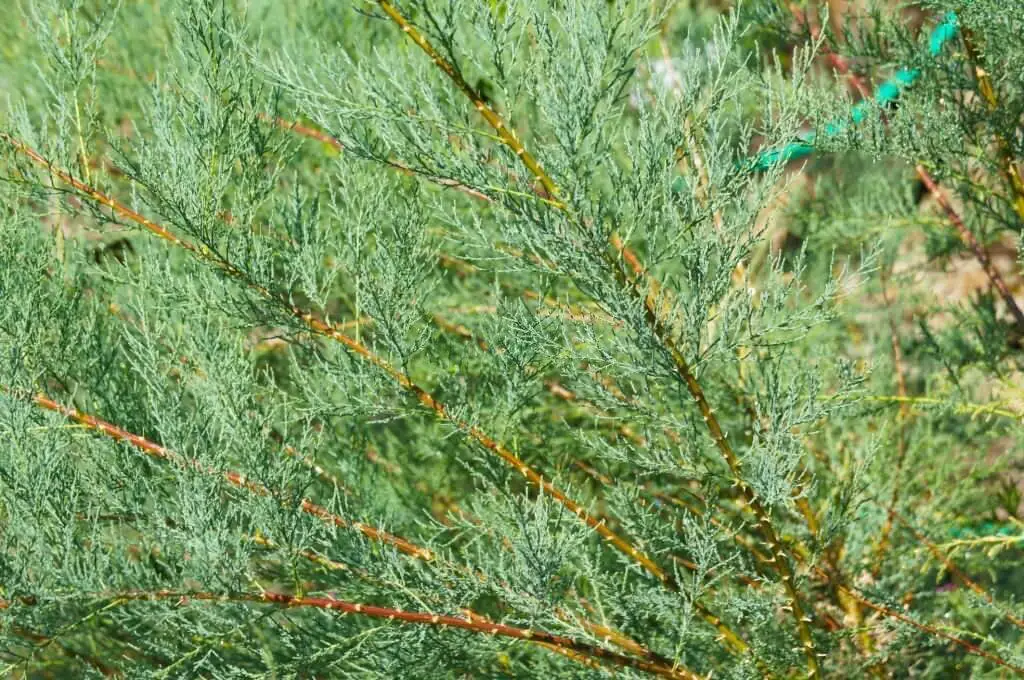
Rocky Mountain Juniper (Juniperus scopulorum) thrives in zones 3 to 8, native to western North America. Its vast range spans eastern Montana, Wyoming, and South Dakota, extending south through Colorado and Utah to northern Arizona, and into Mexico’s Chihuahua and Sonora regions.
This majestic tree grows columnar or conical, reaching heights of 20-35 meters (66-115 feet) with trunks up to 60 centimeters (24 inches) in diameter.
Its needle-like leaves come in two forms, borne on long shoots and short shoots respectively.
The cones are distinctive berry-like structures, featuring a blue-black hue with a white waxy coating, containing three to seven seeds each. They mature roughly 18 months after pollination.
Rocky Mountain Juniper is a popular ornamental tree in parks and large gardens, also utilized for reforestation efforts on mine spoils in the western United States.
However, it has demonstrated aggressive invasive tendencies outside its natural range, highlighting the importance of responsible planting practices.
Skyrocket Junipers (Juniperus Virginiana ‘Skyrocket’)
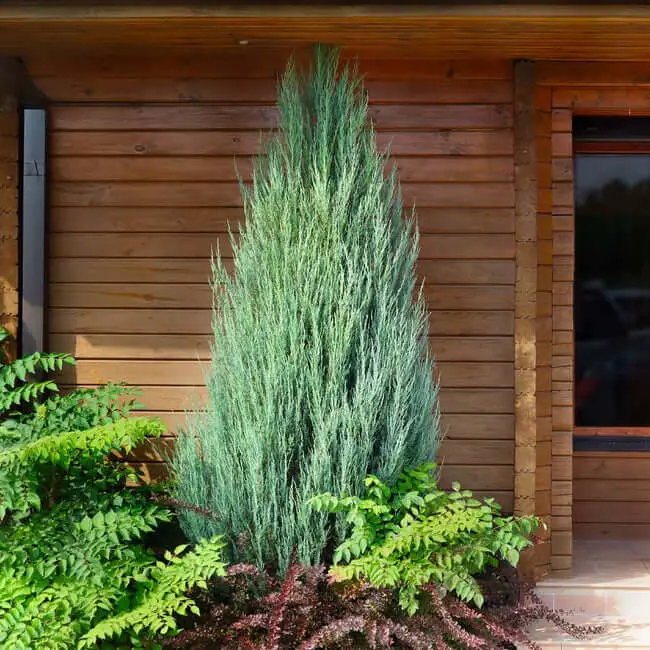
With the ability to thrive in zones 4 to 9, skyrocket junipers have earned a reputation as one of the most sought-after varieties. Their impressive growth rate, striking columnar shape, and lush foliage make them an ideal choice for creating privacy screens, windbreaks, or adding visual interest to your landscape design. While their name might suggest otherwise, these trees actually grow at a moderate pace, reaching heights of 20-30 feet with a relatively narrow width of three to five feet.
One of the key advantages of skyrocket junipers is their low-maintenance requirements – they’re quite forgiving when it comes to upkeep. However, some pruning is necessary to preserve their unique shape and prevent them from becoming leggy or unkempt. The ideal time for pruning is in late winter or early spring, just before new growth begins, ensuring your tree stays healthy and looks its best.
Spartan Juniper (Juniperus chinensis ‘Spartan’)
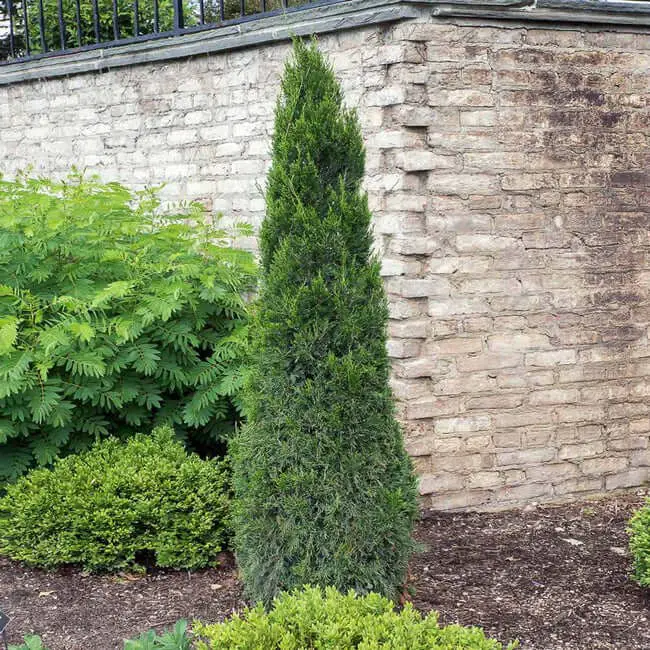
With its ability to thrive in zones 5 to 9, the Spartan juniper is an excellent option for homeowners seeking a reliable and easy-to-care-for evergreen shrub. Reaching heights of up to 15 feet tall and wide, this dense, slow-growing plant boasts small, dark green needles that can withstand a broad range of climates and soil types. Perfect for hedges, screens, or foundation plantings, the Spartan juniper is a versatile choice that requires minimal upkeep.
Its natural tolerance to drought, deer resistance, and ability to thrive in both full sun and partial shade make it an ideal selection for those seeking a low-maintenance yet visually appealing addition to their outdoor space.
Taylor Juniper (Juniperus virginiana ‘Taylor’)
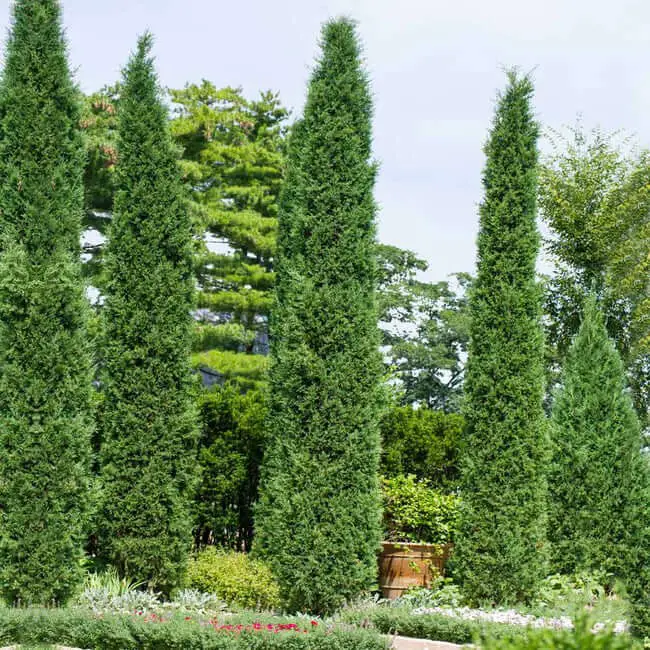
With its hardiness spanning zones 3 to 9, the Taylor Juniper offers a versatility unmatched by many other evergreens. Native to the United States, this adaptable species can thrive in a range of conditions, making it an excellent choice for creating privacy hedges or screens. Its dense, green foliage and pyramidal shape provide year-round visual interest, while its drought-tolerant and salt-tolerant properties make it well-suited for coastal areas.
For those seeking a low-maintenance evergreen that will add depth and beauty to their landscape, the Taylor Juniper is an outstanding option.
Utah Juniper (Juniperus osteosperma or J. utahensis)
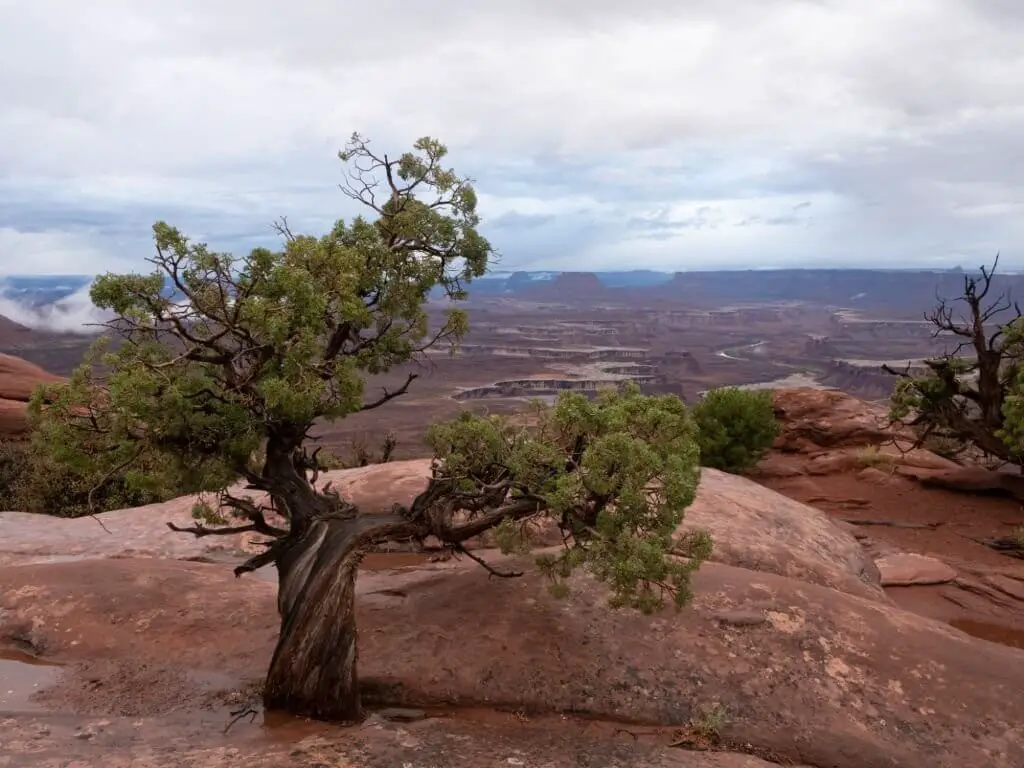
The Utah Juniper is a species of juniper native to western North America, ranging from southeastern Alaska to southwestern Colorado and northern Mexico. This evergreen shrub thrives at elevations between 900-3000 meters. Its needle-like leaves are arranged in opposite pairs or whorls of three, featuring a striking white stomatal band on the inner surface.
The foliage is characterized by two distinct types: juvenile needles and adult scales, with the former being larger (up to 12 mm) and more pointed than the latter. The plant’s cones are berry-like, fleshy, and blue-black in color, covered in a white waxy coating. Each cone contains one to three seeds and takes approximately 18 months to mature. Notably, the male cones are smaller (up to 0.75 cm) than their female counterparts, shedding pollen in early spring.
Western Juniper (Juniperus occidentalis)
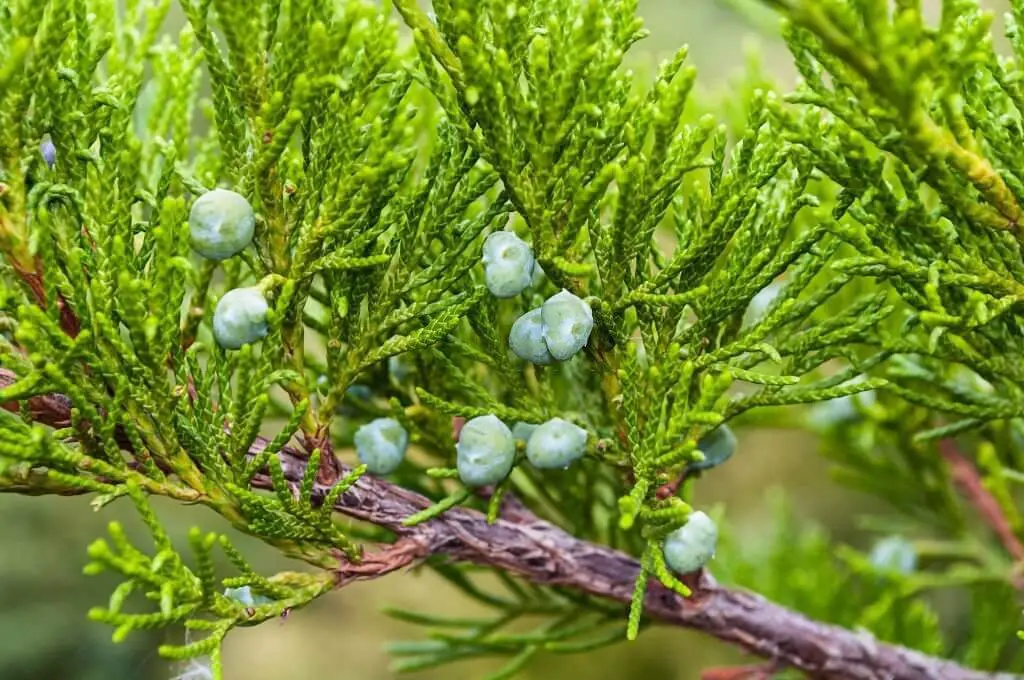
Western Juniper, also known as Sierra Juniper or Rocky Mountain Juniper, is a native species found in the western United States. Its range spans across California, Oregon, Nevada, Idaho, Utah, and Wyoming. This tree can grow quite tall, reaching heights of 15 to 30 meters (50 to 100 feet) with a trunk diameter of up to 0.75 meters (30 inches). The leaves are notable for their distinct juvenile and adult forms: needle-like and scale-like in the former, and awl-shaped in the latter.
When it comes to cones, Western Juniper produces berry-like structures featuring a fleshy outer layer and a woody inner layer. These berries can range in color from blue to black, with each containing up to three seeds. Interestingly, this species is dioecious, meaning male and female cones are found on separate trees.
How to care for juniper trees
When it comes to pruning your juniper tree, timing is everything. The ideal moment is during the early spring, before new growth begins. Start by removing any dead or diseased branches that might be compromising the overall health of your tree. Next, tackle any long or wayward branches that are detracting from the tree’s natural shape. This will help you create a more compact and visually appealing structure.
For added benefits, thin out the interior to improve air circulation and allow more light to reach those lower branches. It’s crucial to use sharp, clean tools during this process to avoid causing unnecessary damage to your juniper. After completing the pruning, be sure to give your tree a thorough watering. This will help it recover from the stress of being pruned and encourage new growth. Take your time when watering, ensuring that the roots have ample opportunity to absorb the water.
With these simple steps, you can keep your juniper tree healthy and thriving for years to come.
FAQs about juniper trees
What is the shortest juniper?
While Juniperus scopulorum, or Rocky Mountain juniper, stands out as the shortest species of juniper, with a modest height of 15 feet (45 cm) and trunk diameter of around 12 inches (30 cm), it is by no means less remarkable. Native to mountainous regions in western United States and Canada, this juniper has earned its place as a popular ornamental plant due to its compact size and pyramidal shape. Furthermore, the Rocky Mountain juniper holds a special distinction as Wyoming’s state tree.
Meanwhile, Juniperus virginiana, or Eastern red cedar, is another notable species that shares similar characteristics, growing up to 20-30 feet (60-90 cm) in height with a trunk diameter of approximately 18 inches (45 cm). Originally hailing from eastern United States and Canada, this juniper thrives in forested areas and has gained popularity as an ornamental plant due to its conical shape and compact size.
Are there male and female juniper trees?
While the notion of sexual differentiation among juniper trees remains shrouded in mystery, two theories have emerged. Some botanists propose that these evergreens exhibit a binary gender system, with distinct male and female specimens. In contrast, others suggest that all junipers are hermaphroditic, possessing both male and female reproductive organs.
As the debate continues, it’s clear that further research is necessary to unravel the truth about the reproductive habits of these fascinating trees.
What is the lowest growing juniper?
The smallest-growing juniper species is the Prostrata Juniper, which originates from Japan and Korea. It’s a compact shrub that typically reaches a height of around two feet, making it an ideal choice for ground cover or low hedges. Despite its small stature, this juniper boasts dense foliage with dark green leaves and can thrive in poor soil conditions as well as full shade.
If you’re looking for a juniper that will remain relatively diminutive, the Prostrata Juniper is definitely worth considering.
Are junipers low maintenance?
Juniper care requirements vary depending on the specific species or cultivar you’re working with. While some may be relatively low maintenance, others demand a bit more attention. That being said, junipers are generally easy to care for and can make excellent landscape choices. When planted and cared for properly, they can flourish in a wide range of conditions.
Is juniper poisonous to dogs?
While it may seem like a harmless addition to your garden, juniper plants can actually pose a significant threat to our canine companions. The berries and leaves of the juniper plant contain toxic compounds that can cause a range of unpleasant symptoms in dogs if ingested. The most common signs of juniper poisoning include vomiting, diarrhea, abdominal pain, and lethargy. In more severe cases, juniper consumption can even lead to liver damage or, in extreme situations, prove fatal.
If you suspect your dog has accidentally snacked on some juniper, it’s essential to seek veterinary attention as soon as possible.
What are juniper trees good for?
Juniper trees are often overlooked as a valuable addition to any landscape. They offer a multitude of benefits, including their ornamental value, ability to provide privacy and windbreaks, and capacity for soil stabilization on slopes and hillsides. Furthermore, junipers’ natural drought-tolerance makes them an ideal choice for areas with water scarcity concerns.
As such, these trees can play a crucial role in conserving water while still serving as a visually appealing feature in your outdoor space.
Is a juniper tree a pine tree?
Despite sharing some superficial similarities with pine trees, junipers belong to a distinct plant family. While both types of coniferous plants boast needles and cones, their differences lie in more than just aesthetics. Junipers typically sport a single trunk, whereas pines often display multiple trunks. Furthermore, the length of their respective needles varies significantly, with pines sporting longer needles compared to junipers.
Moreover, the cone structures differ substantially as well; pine cones dangle downwards from branches, whereas juniper cones face upwards.
Conclusion
In conclusion, the diverse world of junipers offers a wide range of options for any landscape. From common varieties to more rare ones, each type can be easily distinguished by its distinctive features. With proper care, junipers can flourish in even the most demanding environments. Whether you’re seeking a low-maintenance groundcover or a majestic evergreen tree, there’s a juniper variety that’s sure to impress.
As with any plant, the key to success lies in providing the right conditions for it to thrive. So why not get started and explore the many wonderful types of junipers out there? We’d love to hear about your favorite type in the comments below! And don’t forget to check out our other articles on trees and shrubs for more insights into these remarkable plants.
Related Posts
Transforming your outdoor space with a diverse range of plants from an online plant nursery can be an exciting experience. From the majestic apple trees to lush evergreens, the possibilities are endless. But before you start planting, have you considered becoming an arborist? A career in tree care requires dedication and expertise, but it’s also incredibly rewarding. Understanding the impact of trees on your property is crucial for any homeowner or gardener.
Not only do trees boost a home’s appeal, but they can also provide shade, improve air quality, and even increase its value. Of course, sometimes removing trees is necessary to make way for new growth. The lady palm (Rhapis excelsa) is a popular choice for indoor spaces due to its unique fronds and low-maintenance care. Meanwhile, growing organic blueberry plants in your garden can be a fun and fruitful experience.
With the right tips and techniques, you can enjoy a bountiful harvest of juicy, sweet blueberries.


